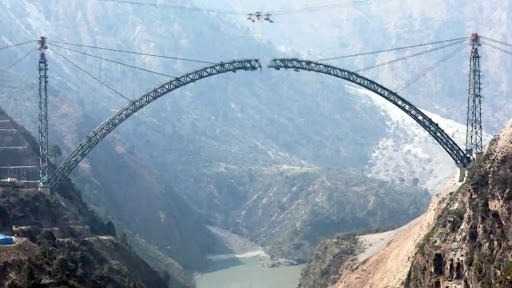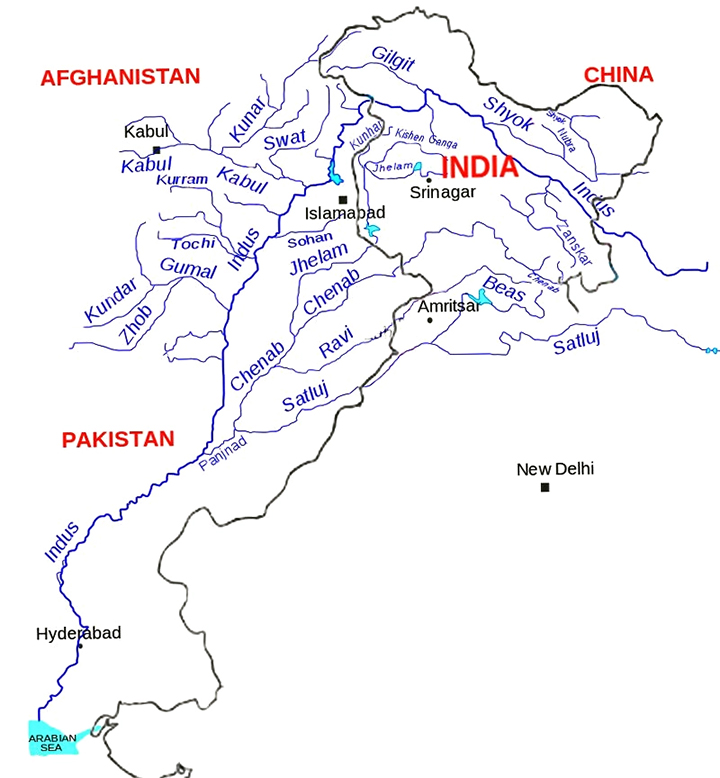Online Learning Portal
Online Learning Portal

Monthly DNA
![]() 07 Apr, 2021
07 Apr, 2021
![]() 30 Min Read
30 Min Read
Recently, Indian Railways completed the arch closure of the iconic Chenab Bridge in Jammu & Kashmir.
Key Highlights

Chenab River

Source: PIB
The International Monetary Fund’s (IMF) World Economic Outlook has raised its Financial Year (FY) 2021 growth forecast for India to 12.5% from 11.5% estimated earlier in January 2021.
Highlights of the Report:
Suggestions:
Priorities:
International Monetary Fund
Reports by IMF:
World Economic Outlook
Source: TH
The Defence Minister of Kazakhstan visited India recently with a focus on boosting bilateral defence cooperation. Both countries share common interests of actively combating the threat of global terrorism and maintaining peace.
The meet will enable greater military to military contact and cooperation between Kazakhstan and India.
India – Kazakhstan Relations:
Relations between India and Kazakhstan are ancient and historical going back to more than 2000 years.
Political Relations
Defence cooperation
Trade And Economy Cooperation
Space Cooperation
Civil Nuclear Cooperation
Significance of Kazakhstan to India
Source: TH
Prime Minister Shri Narendra Modi will chair a meeting of the High-Level Committee to approve policies, plans and programs related to the commemoration of the 400th birth anniversary of Sri Guru Tegh Bahadur Ji.
Guru Tegh Bahadur (1621–1675)
Impact of his martyrdom
Sikh Gurus
1. Guru Nanak Dev - Guru from 1469 to 1539
2. Guru Angad Dev - Guru from 1539 to 1552
3. Guru Amardas Sahib - Guru from 1552 to 1574
4. Guru Ram Das - Guru from 1574 to 1581
5. Guru Arjan Dev - Guru from 1581 to 1606
6. Guru Har Gobind Sahib - Guru from 1606 to 1644
7. Guru Har Rai Sahib - Guru from 1644 to 1661
8. Guru Har Krishan Sahib - Guru from 1661 to 1664
9. Guru Tegh Bahadur Sahib - Guru from 1665 to 1675
10. Guru Gobind Singh Sahib - Guru from 1675 to 1708
Guru Granth Sahib
Source: PIB
What is JCPOA? About Iran nuclear deal?
Why did Iran agree to the deal?
Iran’s objective
Why did the US pull out of the deal?
Impact of escalated tensions between Iran and the US:
Implications for India:
What role does the U.N. Security Council play in this crisis?
Global Implications:
For an editorial on the USA – Iran issues: click here https://www.aspireias.com/daily-news-analysis-current-affairs/USA-Iran-issues
For recent news on USA – Iran nuclear deal and IAEA: click here https://www.aspireias.com/daily-news-analysis-current-affairs/Iran-Nuclear-Deal-and-JCPOA
Source: TH
K-Shaped Recovery A K-shaped recovery occurs when, following a recession, different parts of the economy recover at different rates, times, or magnitudes. This is in contrast to an even, uniform recovery across sectors, industries, or groups of people. A K-shaped recovery leads to changes
K-shaped recovery- Equitable access post COVID Introduction A recent Pew Research Report shows that India’s middle class may have shrunk by a third due to the novel coronavirus pandemic while the number of poor people earning less than ?150 per day more than doubled. The Pew repor
The Supreme court must hold Circuit benches Introduction It is ironic that it has taken a pandemic to acknowledge the significance of fair and equal access to the Supreme Court through virtual hearings Increasing reach Even at the time the Constitution was being debated by the Co
U.S. and China need each other Introduction U.S. President Joe Biden has called Chinese President Xi Jinping and North Korean President Kim Jong-un “thugs”, Turkish President Recep Tayyip Erdogan an “autocrat” and Russian President Vladimir Putin a “killer&rdqu
Moaists- Tarrem attacks Introduction Tarrem attacks indicate that the weakened Maoists remain a strong military threat Details of the attack The deaths of over 20 paramilitary personnel in an encounter with the Maoists in the Tarrem area near Chhattisgarh’s Sukma district
Indian astronomers from Aryabhatta Research Institute of Observational Sciences have tracked a rare supernova explosion and traced it to one of the hottest kind of stars called Wolf–Rayet stars or WR stars. The rare Wolf–Rayet stars are highly luminous objects a
India's Rising Supercomputing Capabilities India is fast emerging as a leader in high-power computing with the National Super Computing Mission (NSM) boosting it to meet the increased computational demands of academia, researchers, MSMEs, and startups in areas like oil exploration, flood pred
First Meeting of BRICS Finance Ministers and Central Bank Governors As 2021 BRICS Chair, India’s approach is focused on strengthening intra-BRICS cooperation based on Continuity, Consolidation and Consensus. BRICS Finance Ministers and Central Bank Governors discussed the financial coope
92% of Projects under PMAY-G Completed Under the Pradhan Mantri Awaas Yojana – Gramin (PMAY-G), 92% target of completion has been achieved in the 1st phase of the scheme i.e. from 2016-17 to 2018-19 with intended beneficiaries also coming down from 2.95 cr to 2.14 cr due to duplication
Global Gender Gap Report 2021 Global Gender Gap Report 2021 was released recently. Released by World Economic Forum Key takeaways India has fallen 28 places It is now one of the worst performers in South Asia, It is ranked below neighbouring countries &nd
US Visa regime during the Biden era Introduction Biden shows intent on reworking immigration rules by not extending the H-1B visa ban Details President Joe Biden allowed a ban on the issuance of H-1B visas for skilled workers to lapse at the end of March 2021.. Mr. Biden&rsquo
National Policy for Rare Diseases, 2021- Analysis Introduction The recent notification of the National Policy for Rare Diseases 2021 is pegged on this principle of inclusion. Details of the policy It offers financial support for one-time treatment of up to ?20 lakh, Introduce
Blockchain Enabled Interface for Indian Spices Spices Board India and UNDP India's Accelerator Lab sign MoU to develop a blockchain-powered traceability Interface for Indian spices. This new interface will serve to enhance transparency in the supply chain and trade. India is the
Impacts of Desert Dust Particles on Indian Summer Monsoon A new study shows the impacts of desert dust coming from the West, Central, and East Asia in the Indian Summer Monsoon. Impact of Desert Dust Particles on Indian Summer Monsoon: Strong winds carry the dust particles from the
Exercise La Perouse Indian Navy Ships are participating, for the first time; in the multi-lateral maritime exercise La Pérouse, conducted in the Eastern Indian Ocean Region The Indian Navy ships and aircraft will exercise with ships and aircraft of the French Navy, Royal Au
Advanced Chaff Technology by DRDO for Naval Safety DRDO has developed an Advanced Chaff Technology to safeguard the naval ships against enemy missile attacks. The successful development of Advanced Chaff Technology by DLJ is another step towards Atmanirbhar Bharat. Ch
Increased FDI Inflows in FY 2020-21 India has attracted the highest ever total FDI inflow of US$ 81.72 billion during the financial year 2020-21 and it is 10% higher as compared to the last financial year 2019-20 (US$ 74.39 billion). FDI equity inflow grew by 19% in the F.Y. 2020-21 (US$ 59
Our Popular Courses
Module wise Prelims Batches
Mains Batches
Test Series